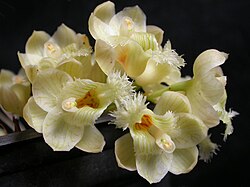| Clowesia | |
|---|---|
 | |
| Clowesia amazonica | |
| Scientific classification | |
| Kingdom: | Plantae |
| Clade: | Tracheophytes |
| Clade: | Angiosperms |
| Clade: | Monocots |
| Order: | Asparagales |
| Family: | Orchidaceae |
| Subfamily: | Epidendroideae |
| Tribe: | Cymbidieae |
| Subtribe: | Catasetinae |
| Genus: | Clowesia Lindl. |
| Type species | |
| Clowesia rosea Lindl. | |
| Synonyms [1] | |
WarczewitziaSkinner ex Lindl. | |
Clowesia is a genus of the family Orchidaceae. Species of this genus are epiphytic and contain many pseudobulbs with several internodes. The leaves of this plant are arranged alternatively in two vertical rows on opposite sides of the rachis. Clowesia has a simple gullet flower that allows for pollination by male euglossine bees. The flowers are often unisexual and contain a viscidium.




